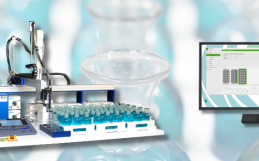PeCOD® Analyzer Harnesses Hydroxyl Radicals for Rapid, Eco-Friendly Water Testing
Did you know that a main component of the PeCOD® analyzer’s chemistry is based on a treatment process that leverages hydroxyl radicals? In fact, hydroxyl radicals greatly contribute to its rapid, safe, and green method. This makes it an ideal tool for industries performing water and wastewater tests such as biochemical oxygen demand (BOD), chemical oxygen demand (COD), permanganate index and total organic carbon (TOC). Incorporating the PeCOD® analyzer as a water testing tool provides operators & engineers with timely results using a method that protects users’ health and and the environment.
Hydroxyl Radicals in Water Treatment Explained
Advanced oxidation processes (AOPs) are treatment procedures that break down and remove organics in water and wastewater, some of which do so by oxidation through reactions with hydroxyl radicals (·OH). Hydroxyl radicals are powerful oxidizing molecules that react unselectively to surrounding organics which make them effective for treating water and wastewater. PeCOD is the first testing method for organics that uses this principle of “treating” the water with an AOP as the main aspect of its chemistry.
Hydroxyl Radicals in PeCOD Chemistry
The core of the PeCOD® analyzer’s patented technology is its sensor which consists of a TiO2 (titanium dioxide) nanoparticle connected to an external circuit. When UV light activates the nanoparticle, it produces hydroxyl radicals for an advanced oxidation process. Compared to other empirical testing methods, the PeCOD® analyzer is the only one to measure bulk organics by oxidizing the sample with hydroxyl radicals and determining the extent of oxidation through electrochemistry.
Advantages of PeCOD Utilizing Hydroxyl Radicals for Testing
Leveraging hydroxyl radicals offers several advantages. Firstly, they are non-selective and can react with virtually all organics giving a true measure of all organics present in the sample. Secondly, they are highly reactive meaning the process of oxidation is faster which equates to faster analysis. Moreover, they are a green oxidant which means they do not produce harmful by-products after analysis.
Comparing PeCOD to Other Methods that Measure Bulk Organics
Other empirical methods which test bulk organics use other methods to oxidize and often require extensive sample preparation, the use of hazardous chemicals, and can be time-consuming. This makes them not as accessible to operators & engineers as their procedures and reagents can put users’ health and safety at risk. Waiting too long for results is also not useful for timely decision making.
For instance, the BOD5 test is very time-consuming as it requires a 5-day incubation period before obtaining results. On the other hand, the COD by dichromate method takes less time (2-3 hours) than the BOD5 test, however it is highly dangerous. It performs chemical digestion with high heating temperatures and utilizes reagents (dichromate, mercury, acid) harmful to human health. Additionally, this method produces hazardous waste which requires special disposal. The permanganate index involves concentrated acid and a complex sample preparation procedure restricted to trained laboratory personnel. TOC analyzers are not sensitive to oxidative changes in natural organic matter (NOM) and just quantify carbon without providing indication of reactive potential.
Although there are optical surrogate measurements methods that can obtain results rapidly without using harmful reagents, they merely measure specific wavelengths and don’t obtain empirical results, therefore they must be calibrated on a matrix-specific basis and often cannot be compared between different sampling sites.
In contrast, the PeCOD® analyzer utilizes safe and green reagents and only requires 10 minutes or less to obtain empirical results. Since its chemistry involves an advanced oxidation process, the sample is essentially treated during analysis so it exits the analyzer cleaner than it entered and can be safely disposed down the drain. By using UV to form hydroxyl radicals for its oxidation chemistry, the peCOD method does not require users to handle and be exposed to harmful reagents, therefore it is a far less dangerous method that protects the health & safety of its users.
Implementing PeCOD for Water & Wastewater Monitoring
The PeCOD® analyzer is highly configurable meaning it can be incorporated in a variety of settings; from remote field locations (portable), within industrial plants (benchtop or automated) or directly from on the process line (online), making it an invaluable tool for water & wastewater monitoring. Its implementation can serve as an early warning system by identifying potential issues before they escalate into larger environmental crises.
Overall, utilizing the PeCOD® analyzer can greatly improve water quality management due to its rapid, safe and green chemistry. Operators and engineers can respond quickly to contamination events as well as optimize their process without exposure to harmful reagents. All leading to better protection of human health and the environment.








